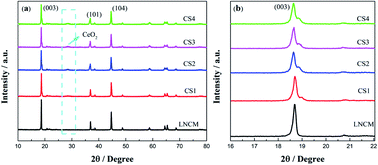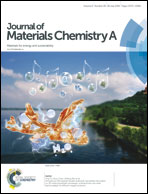A novel surface-heterostructured Li1.2Mn0.54Ni0.13Co0.13O2@Ce0.8Sn0.2O2−σ cathode material for Li-ion batteries with improved initial irreversible capacity loss†
Abstract
The modification of lithium-rich layered cathode materials has been widely studied by surface coating, doping and chemical treatment for lithium-ion batteries. However, controlled synthesis of advanced electrode materials with high capacity, high reaction activity, and structural stability is still a considerable challenge in practical applications. Herein, we develop a simple and efficient method to replace the traditional wet chemical deposition route for the synthesis of CexSn1−xO2−σ hybrid coated Li-rich Li1.2Mn0.54Ni0.13Co0.13O2 (denoted as LNCM@CexSn1−xO2−σ, 0 < x ≤ 1) materials as cathodes by a versatile solvothermal method. The obtained LNCM@CexSn1−xO2−σ materials are further characterized by XRD, Raman, XPS, SEM, and TEM. It is revealed that the synthesized Ce0.8Sn0.2O2−σ material possesses abundant oxygen vacancies and exists in the form of nanoparticles with a size of about 10 nm on the surface of Li1.2Mn0.54Ni0.13Co0.13O2 (CS3). Meanwhile, a spinel-phase layer is formed between the nanoparticles and host material. As anticipated, a sample modified with CS3 exhibited good rate capability and enhanced cycling stability. More importantly, this modification strategy dramatically reduces the irreversible capacity loss (ICR) of the first cycle for active materials; the ICR lowered to 48.1 mA h g−1 in comparison with the pristine material at a current density of 12.5 mA g−1 (0.05C). Furthermore, an enhanced initial discharge capacity of 315.1 mA h g−1 (0.05C) compared to 285.3 mA h g−1 and an excellent initial coulombic efficiency of 92.77% compared to 79.71% for the pristine one in the potential range of 2.0–4.8 V (vs. Li/Li+) were obtained. Such improvements are mainly ascribed to the fact that the Ce0.2Sn0.8O2−σ material has a good synergistic effect with the pristine LNCM material, which may be the spillover caused by the migration of lattice oxygen from the LNCM phase to the Ce0.2Sn0.8O2−σ phase. In addition, the formation of the spinel structure is beneficial for stabilizing the crystal lattice of the host material and facilitating Li+ diffusion through unique 3D diffusion paths in the surface regions. This newly developed Ce0.8Sn0.2O2−σ hybrid layer can provide a new strategy for the design and synthesis of advanced electrode materials for energy storage devices.



 Please wait while we load your content...
Please wait while we load your content...